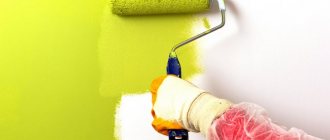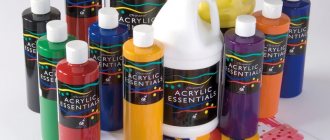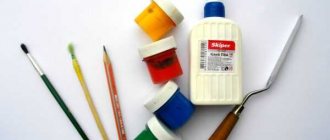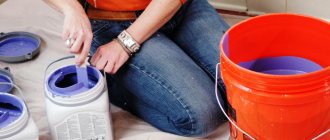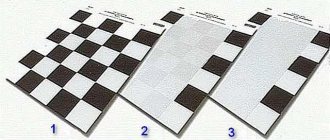When painting various surfaces with acrylic paints, it is often necessary that the composition have the desired consistency, so it is very important to choose the right thinner. If the dilution solution is chosen incorrectly, the consequences can be very sad. Incorrect proportions also impair the quality of the applied mixture.
In what cases is dilution required?
Acrylic paint is diluted if:
- this is required by the technical data of the LKS;
- this is necessary for adhesion to the surface to be coated;
- the dye has thickened or begun to dry out.
In the first option, pay attention to the recommendations from the manufacturer, who in the instructions provides step-by-step guidance on which solvent for acrylic paints to use and how to do it.
In the second and third cases, the question: how and with what to dilute acrylic paint is decided based on the direction of the upcoming operations. For example, how to paint a ceiling without streaks with acrylic paint. A substance that is too thick or thin will not solve this problem. For uniform painting of the ceiling and walls, the composition should be dense, but not thick. Otherwise you will have to apply 3-4 layers.
Additional recommendations
Working with acrylic paints has nuances and secrets. Here are some of them:
The water must stand for 2-3 hours so that the impurities settle to the bottom. Only after this can it be used to dilute acrylic paints.
When applying the composition using a spray gun, work with branded solvents, adhering to the proportions recommended by the manufacturer. This way you will get a liquid of uniform consistency and achieve uniform coloring of the surface.
Rinse brushes and rollers thoroughly, especially if the work was performed with a highly diluted liquid. This composition is difficult to notice, so the particles remain between the villi. If you subsequently use paint of a lighter shade, the color will be spoiled.
Add the diluent to the composition in portions, thoroughly mixing the composition after each dose. To do this, use a special mixer.
It is not recommended to purchase the material “back to back” - it is advisable to leave a small amount of paint unused. This is necessary for spot restoration of the surface in case of accidental damage.
Regardless of what you choose to thin your acrylic paint with, test the product with a small amount of colorant. If you notice the formation of lumps, you will have to choose another option.
Dilution with water
Before thinning acrylic paint if it has dried, it is recommended to pay attention to its consistency. Typically this is a thick mixture. To choose a diluent, you need to correctly determine the amount of water in the composition, the component component of which can be 60%. Therefore, the dilution method is considered to be dilution with water.
When deciding what to do if acrylic paints have dried, to obtain the desired result, observe the following conditions:
- Temperature indicator. It is important not only what acrylic paints are diluted with, but also the state of the external environment. The air temperature is allowed not lower than 15°C and not higher than 20°C.
- Compound. The degree of purification of the diluent is also important: the liquid must be free of impurities. It is recommended to use distilled or settled boiled water for this purpose.
- Proportions. The required concentration is achieved by the correct ratio of water and coloring product:
- the mixture diluted in such proportions has a liquid consistency. The result is used as a basis for the base coat. This option is used if sprayers are used in the work;
- viscous substance that gives a dense covering layer;
- the ratio of acrylic to liquid required when forming a primer mixture for a highly porous surface. Also, a similar technique is used in design when finishing and tinting textured parts. The absorbent composition gives an even thin coating and dries quickly.
Solvents and thinners
Water is a natural solvent for acrylic paint. In addition to water, there are a number of diluents offered by the chemical industry that restore the structure of lx. Based on their coefficients, they are divided into three groups.
- Artistic thinners – used in painting and interior design.
- Specialized - manufactured for use in a specific area, taking into account the specific characteristics of the consumer sector. For example, if textile paints have dried out.
- Universal - organic thinners used in all acrylic paints.
Based on drying speed, solutions are divided into three groups, each of which has specific temperature values recommended.
- Slow. This type of acrylic paint thinner is recommended for use in high temperatures. Such thinners slow down the drying of the dissolved substrate and provide a dense covering layer.
- Average. Dissolution is done for work at temperatures from +15 to +25 degrees.
- Fast. The increased evaporation rate reduces the time of complete drying and the removal of excess moisture in low temperature conditions. They are designed for use at -15°C. If the question is: how to dilute façade acrylic paint, then this type of solvent is used.
How to dilute with solvents
In 90% of cases, solvents are colorless, with a distinct specific odor. These products are used to change the texture of acrylic paints and obtain a matte or glossy surface. Unlike water, which can add “cloudiness” to the color, special thinners do not have such a negative effect.
The proportions of adding such funds depend on the type of proposed work. If there is a lot of solvent, the texture will become translucent; if there is little solvent, the thick, rich color will remain. Manufacturers give recommendations for dilution, follow them.
The use of solvents depends on the air temperature.
When painting in cold weather, use solvents with a high drying speed to ensure the paint has good adhesion to the surface.
At normal temperatures, use compounds with an average drying speed. They are considered universal and suitable for all types of work.
Slow drying solvents are designed for hot weather and prevent water from evaporating too quickly.
It is important to understand that a properly selected solvent improves the performance characteristics of the composition, affects the strength of the coating and color saturation.
Solvents that are compatible with acrylic paints:
gasoline and white spirit - compositions with a high drying rate;
kerosene – average volatility value;
turpentine - slow evaporation.
There are positive reviews about RELOCRYL ACRYL , which is designed specifically for diluting acrylic paints, varnishes and primers.
If the composition gets on a surface not intended for painting, it is washed off using a solvent remover. The composition is available in the form of a paste. It is applied to the desired area and left for 10-15 minutes . The remover dissolves the acrylic and excess is easily removed.
Regardless of the chosen option, it is important that two rules are followed - the resulting solution should not coagulate, and the presence of lumps is unacceptable.
Restoration of thickened composition
How to dilute acrylic paint. If the mixture has dried out, this is the result of storing the product in improper conditions. Acrylic lacquers differ from other types of dyes in the ability to restore the desired consistency. The thickened substrate is well diluted and dissolved. To correct the situation, just add distilled water to the paint and mix it thoroughly with a construction mixer.
If there are clots and lumps in the mixture, then alcohol can be added.
Paint for the spray gun is prepared liquid.
How to restore dried paint
Before diluting the acrylic paint, prepare all the necessary components.
- dry dye is removed from the container;
- the dried pieces are first crushed to a powdery state;
- The powder is placed in a wide-necked container, poured with hot water and stirred.
- after 5-10 minutes the mixture is drained and the procedure is repeated several times.
- the resulting substance is passed through a filter to remove undissolved particles. For this purpose, you can use regular gauze folded in several layers.
When dissolved, the material loses some properties. Before diluting the suspension, it is necessary to study the manufacturer's recommendations.
Expert advice
- if the paint has dried, in order to avoid moisture evaporation, it should be diluted in a small container;
- A tight-fitting jar lid will help get rid of excessive drying;
- It is recommended to wash all tools immediately after completion of work;
- Completely removing dried acrylic paint is a labor-intensive process. Therefore, it is better to cover the surrounding area with protective materials in advance.
The quality of the covering layer directly depends on the degree of viscosity of the paintwork material. Mistakes made can affect not only the appearance of the painted surface, but also the service life.
Acrylic-based paint is one of the popular materials for decorating building facades and carrying out interior work. It is quite easy to apply, but due to its thick consistency, the coating sometimes turns out uneven or too rich. This problem can be easily avoided if you know how to dilute acrylic paint.
Acrylic paint is an excellent material for finishing
Decorative coating components
Before using this or that paint, it is advisable to understand what substances are included in it. After this, most likely, the problem of choosing a solvent will disappear by itself.
All acrylic paint mixtures have three main components:
- water;
- coloring pigment;
- binders.
The last ingredient in acrylic paint is a polymer emulsion, which contains acrylic. This determines the choice of name for the decorative material in question.
Acrylic paint pigment
Paint has a very wide range of applications: from facade work to coating indoor surfaces. In this case, it practically does not matter what material is painted.
In addition, one of the features of a paint composition containing acrylic is its resistance to ultraviolet radiation. Therefore, the surface remains bright and attractive for a long time.
Well, the last advantages are the price, which makes the finishing material in question one of the most affordable on the market, and ease of use, which is especially important if you decide to carry out repairs yourself.
Advice! It is recommended to use acrylic paint in strict accordance with the manufacturer's recommendations indicated on the label. This way you will achieve the best results.
Peculiarities
Acrylic paints include three elements:
- pigment that gives color tone
- binder (most often resin),
- water.
This composition ensures the environmental friendliness of the material. During work, the paint does not emit toxic fumes or odors. The presence of water makes the paint non-flammable. These qualities ensure the safety of using the material in office and residential premises.
If necessary, obtain the desired shade can be diluted with a coloring pigment. The presence of water allows the material to dry quickly. If it dries out, the material can be easily returned to its original state by diluting it with water.
Thinning dried acrylic paint
Often, improperly stored material dries out and becomes unusable. Most often it goes straight to the trash can. However, if you wish, you can restore the paint. Of course, its characteristics will decrease somewhat.
To do this you need:
- Grind the existing paint in the can with a sharp object until it reaches the consistency of a fine powder.
- Pour boiling water and let the mixture warm up well.
- After the liquid has cooled, the procedure should be repeated.
- Then drain the excess water, mix the contents of the jar and bring to the desired consistency using a solvent.
Dried acrylic paint can also be brought back to life
What to do if the paint has dried
It is impossible to accurately calculate the amount of material needed, so professional builders prefer to take it in reserve. After interior finishing, there are situations when some amount of paint remains unused.
The remainder in the jar gradually dries out - the moisture evaporates over time, and polymerization begins. The more liquid “leaves”, the lower the performance characteristics of the composition.
You shouldn’t immediately throw away the damaged material: you can try to revive the paint, returning it to its original properties.
Conclusion
Before using acrylic paint, in most cases it must be diluted with water or a solvent. Using the tips given in the article, you can get material that best suits your needs. With its help, you can bring your wildest design fantasies to life.
You can learn more about painting from the video in this article.
If you decide to buy acrylic-based facade paint for facade finishing or interior work, then you should understand all the nuances of using such a coating. Only in this case can you count not only on a beautiful shade of the walls, but also on the long service life of the resulting decor. This finish is quite easy to apply, but the consistency of the material in the packaging is too thick. If you use it without diluting it, the paint layer on the wall will inevitably be either uneven or too thick, which will negatively affect costs. It is worth clarifying how to dilute façade paint with water in order to obtain high-quality decor.
Water-based paint and its types
So, first you should figure out what water-based paint is? This is a water-based paint and varnish material. Most often it is used for interior decoration - painting walls and ceilings, but some of its varieties are also suitable for exterior work.
Water-based paints come in several types:
- polyvinyl acetate: their base is PVA glue, and the main advantage is an affordable price;
- silicate: they are a solution of liquid glass and do not have good moisture resistance;
- silicone: designed for outdoor use, made on a resin basis and have high strength and durability;
- acrylic: wear-resistant and expensive, the basis for their production is also resin;
- latex: do not fade and are not afraid of water, so they can be washed without fear.
All these types of paints and varnishes can be diluted with water if necessary, and this is a certain convenience.
Decorative finishing components
Acrylic dyes are easy to use and at the same time form a bright, durable coating. They are manufactured based on the following components:
- water;
- pigment;
- polymer emulsion;
- defoamer and a number of other components.
All these components make it possible to obtain a stable liquid mixture, and after drying, a wear-resistant acrylic layer. Diluting this composition with water allows you to achieve the desired consistency of the mixture. However, you can also use a special solvent for dilution, which will give the painted facade a matte or glossy effect.
Water use
How to dilute façade paint with water? The thinner must be clean and cold, and it is also important to keep the proportions exactly. To apply a base decorative layer without clots and drips, it is enough to add an equal volume of liquid to the dye; when painting with a roller, you can increase its amount to a 1:2 ratio. To obtain a translucent film, which is important for emphasizing the decorativeness of textured surfaces or creating a gradient effect, you can dilute the paintwork in a ratio of 1:5-1:15. By varying the amount of thinner, it is possible to obtain a material that optimally meets the user's requirements.
In a similar way, it is quite possible to revive dried acrylic paint. To do this, you need to crumble it and then grind it into powder. After adding boiling water, you need to carefully stir the hot contents of the jar until smooth. Such a coating can be used, although its quality characteristics will be somewhat worse.
How to dilute
So, how can you dilute acrylic facade paint?
There are several ways to dilute such a dispersion. They are necessary to create thin coatings and reduce viscosity caused by water evaporation. The best way is to add special solvents sold in hardware stores. To obtain a glossy surface, a “glossy” thinner is used, and for a matte layer, a “matte” thinner is used. Reducing the viscosity of the acrylic emulsion is necessary for spray application, since high mobility improves the uniformity of the resulting film.
